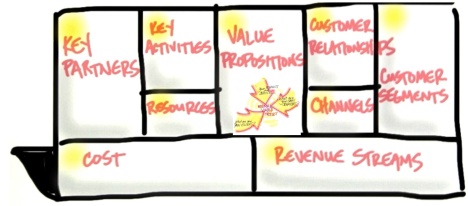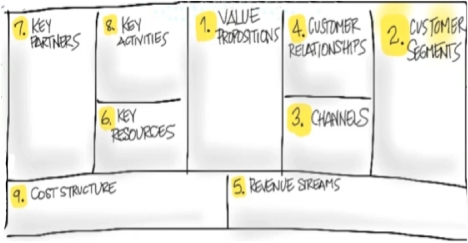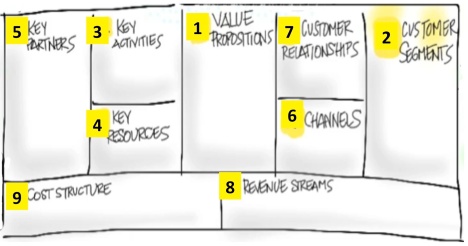We've pivoted our Lean LaunchPad / I-Corps curriculum. We're changing the order in which we teach the business model canvas and customer development to better-fit therapeutics, diagnostics and medical devices.
-
Over the last three years the Lean LaunchPad class has started to replace the last century's "how to write a business plan" classes as the foundation for entrepreneurial education. The Lean LaunchPad class uses the three " Lean Startup " principles:
- Alexander Osterwalders "business model canvas" to frame hypotheses
- "Customer Development" to test the hypotheses outside the building and
- "Agile Engineering" to have teams prototype, test, and iterate their idea while discovering if they have a profitable business model.
Teams talk to 10-15 customers a week and make a minimum of 100 customer visits. The Lean LaunchPad is now being taught in over 100 universities. Three years ago the class was adopted by the National Science Foundation and has become their standard for commercializing science. Today the National Institutes of Health announced their I-Corps @ NIH program.
The one constant in all versions of the Lean LaunchPad / I-Corps class has been the order in which we teach the business model canvas.
Value Propositions and Customer Segments are covered in weeks 1 and 2, emphasizing the search for problem/solution and then product/market fit. Next we teach Distribution Channels (how are you going to sell the product) and Customer Relationships (how do you Get/Keep/Grow customers) and Revenue Streams (what's the Revenue Model strategy and pricing tactics.) Finally we move to the left side of the canvas to teach the supporting elements of Resources, Partners, Activities and Costs.

Teaching the class lectures in this order worked great, it helped the teams understand that the right-side of the canvas was where the action was. The left- hand side had the supporting elements of the business that you needed to test and validate, but only after you made sure the hypotheses on the right were correct.
This lecture order was embedded in the Udacity Lectures, the syllabi and educators guide I open-sourced. Hundreds of teams in the NSF, and my Stanford, Berkeley, Columbia, and UCSF classes learned to search for a repeatable and scalable business model in this way.
It's consistency was the reason that the NSF was able to scale the I-Corps from 15 to 30 University sites.
So why change something that worked so well?
Last fall at UCSF we taught 125 researchers and clinicians in therapeutics, diagnostics, medical devices and digital health in a Lean LaunchPad for Life Sciences class. While the teaching team made heroic efforts to adapt their lectures to our "standard" canvas teaching order, it was clear that for therapeutics, diagnostics and medical devices the order was wrong. Hypotheses about Intellectual Property, Reimbursement, Regulation and Clinical Trials found on the left side of canvas are as, or more important than those on the right side of the canvas.
I realized we were trying to conform to a lecture order optimized for web, mobile, hardware. We needed to cover Intellectual Property, Reimbursement, Regulation and Clinical Trials a month earlier in the class than in the current format.
The National Institutes of Health has adopted our class for its I-Corps @ NIH program starting this October. Most teams will be in therapeutics, diagnostics and medical devices. Therefore we're going to teach the class in the following order:
1) value proposition, 2) customer segments, 3) activities, 4) resources, 5) partners, 6) channel, 7) customer relationships, 8) revenue/costs

I-Corps @ NIH Lecture Order Details
Customer Segments change over time. CROs or Payers may ultimately be a resource, a partner or a revenue source, but until you get them signed up they're first a customer. Your potential exit partners are also a customer. And most importantly, who reimburses you is a customer. (You get an introduction to reimbursement early here, while the details are described later in the "Revenue" lecture.)
Activities are the key things you need to do to make the rest of the business model (value proposition, distribution channel, revenue) work. Activities cover clinical trials, FDA approvals, Freedom to Operate (IP, Licenses) software development, drug or device design, etc.
Activities are not the product/service described in the value prop, they are the unique expertise that the company needs to deliver the value proposition. In this week we generally describe the business rationale of why you need these. The specifics of who they are and how to work with them are covered in the "Resource" and "Partners" lectures.
Resources - Once you establish what activities you need to do, the next question is, "how do these activities get accomplished?" I.e. what resources do I need to make the activities happen. The answer is what goes in the R box (and if necessary, the Partners box.) Resources may be CRO's, CPT consultants, IP, Financial or Human resources (regardless of whether they're consultants or employees.)
Partners are external resources necessary to execute the Activities. You've identified the "class of partner" in the Resources box. This lecture talks about specifics - who are they, what deals work with them, how to get them, how to work with them.
Customer Relationships iswhat we think of as traditional sales and marketing; assembling a SAB, getting the KOL's, conferences, articles, etc. Customer Relationships answers the question, "How will we create demand and drive it to our channel?"

We think we now have a syllabus that will better fit a Life Science audience. Once the syllabus stops moving around we'll open source it along with the educators guide this fall.
Lessons Learned
- The Lean LaunchPad class has started to replace the last century's "how to write a business plan" classes
- The lecture order emphasizes testing the right-side of the canvas first
- That works for almost all markets
- However, for life sciences hypotheses about Intellectual Property, Reimbursement, Regulation and Clinical Trials are critical to test early
- Therefore we created a more effective lecture order for Life Sciences
Filed under: Lean LaunchPad, Life Sciences (NIH), Teaching | 12 Comments "
 StartUp Tools: Must Read Blogs Page 24
StartUp Tools: Must Read Blogs Page 24